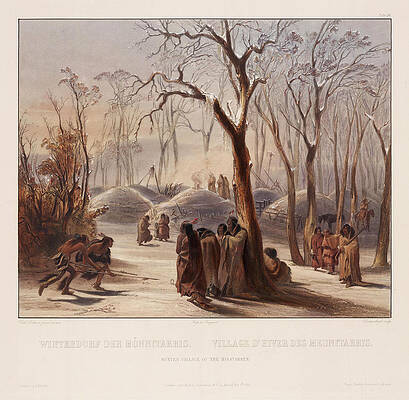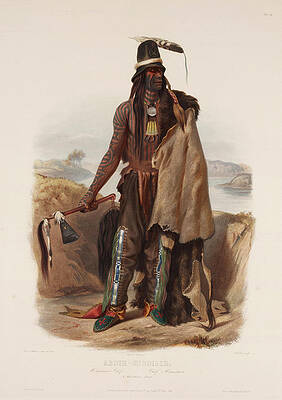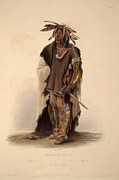Karl Bodmer
Buffalo Robe and other articles of the Mandans
Winter Village of the Manitaries
Addih Haddisch a Mandan Chief
Sioux warrior
Missouria, Otoe, and Ponca Indians
Buffalo dance of the Mandan Indians
Dacota woman and Assiniboin girl
Pehriska Ruppa in the costume of the Dog-band
Pitetapiu an Assiniboin Warrior
Indians on horseback hunting the Buffalo
View of Fort Union the Assiniboins breaking up their Camp
Mato-Tope's representation of a single combat in which he was engaged
Scalp Dance of the Manitaries
Marsh Interior
Messika
Capture of the Calloway Girls and Jemima Boone
Illustrations
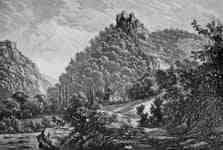
Bernkastel-Kues, castle Veldenz
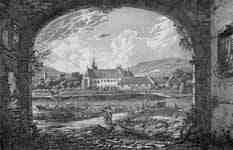
Bernkastel-Kues, hospital at Kues
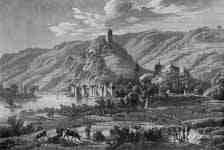
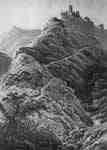
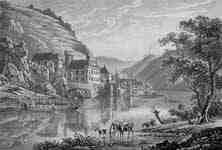
Kobern-Gondorf (Mosel), Gondorf, Moselle
Fine Art Prints | Greeting Cards | Phone Cases | Lifestyle | Face Masks | Men's , Women' Apparel | Home Decor | jigsaw puzzles | Notebooks | Tapestries | ...
Johann Carl Bodmer [1](11 February 1809 – 30 October 1893) was a printmaker, etcher, lithographer, zinc engraver, draftsman, painter, illustrator and hunter. Known as Karl Bodmer in literature and paintings, as a Swiss and French citizen his name has been listed as Johann Karl Bodmer and Jean-Charles Bodmer respectively. After 1843, likely as a result of his son Charles-Henry Barbizon, he began to sign his works K Bodmer.
Karl Bodmer was well known in Germany for his watercolors, drawings and aquatints of cities and landscapes of the Rhine, Mosel and Lahn rivers. As a member of the Barbizon School - a French landscape painting group from the mid-19th century, he created many oil paintings with animal motifs as well as wood engravings, drawings, and book illustrations.
Best known in the United States as a painter who captured the American West of the 19th century with extremely accurate depictions of its inhabitants. He accompanied German explorer Prince Maximilian zu Wied-Neuwied from 1832 through 1834 on his Missouri River expedition. He was hired as an artist by Maximilian with the specific intent of traveling through the American West and recording images of cities, rivers, towns and people they saw along the way, including many images of Native Americans along the Missouri and that region.[2] Bodmer was made a Knight in the French Legion of Honour in 1877. Many of Bodmer's work was chronicled in Prince Maximilian's book entitled Maximilian Prince of Wied's Travels in the Interior of North America.
Early life
Karl Bodmer was born on 6 February 1809 in Zurich, Switzerland. When he was thirteen years old, his mother’s brother, Johann Jakob Meier (a prominent engraver),[3] became Bodmer's teacher. Meier was an artist, having studied under the well-known artists Heinrich Füssli and Gabriel Lory. Young Bodmer and his older brother, Rudolf, joined their uncle on artistic travels throughout their home country.
Missouri River expedition
Map of his 1832-1834 North American travels.
A major turning point in Bodmer's life was his being contracted by Prinz Maximilian zu Wied-Neuwied. Known popularly to naturalists then and even now as Prince Max, this German aristocrat, having successfully led a scientific expedition to Brazil in 1815–1817, decided to embark on another such venture, this time to North America.
By 1828, Bodmer had left his native Switzerland for the German city of Koblenz. It was there that he came to Prince Max's attention. After delays, Bodmer, in the company of Prince Max and a huntsman and taxidermist, David Dreidoppel, set out for America on 17 May 1832. In a letter bearing that date, Prince Max wrote to his brother that Bodmer "is a lively, very good man and companion, seems well educated, and is very pleasant and very suitable for me; I am glad I picked him. He makes no demands, and in diligence he is never lacking."
Fort Pierre on the Missouri and the adjacent prairies, c. 1833. Aquatint by Bodmer from his book "Maximilian, Prince of Wied’s Travels in the Interior of North America.
Arriving in Boston on 4 July, the three encountered hardships and delays caused largely by a cholera epidemic in the eastern states that swept across the north to Michigan. It was not until 8 October that the three began their journey down the Ohio River from Pittsburgh, arriving in Mt. Vernon, Indiana about midnight on 18 October. The next morning, the party made their way to New Harmony, Indiana.
Prince Max had planned to spend only a few days in New Harmony, but his stay "was prolonged by serious indisposition, nearly resembling cholera, to a four months' winter residence." The Prince devotes a whole chapter of his book to New Harmony, its environs, and to the work and personalities of two leading American naturalists who lived there, Thomas Say and Charles-Alexandre Lesueur. Lesueur was also a prolific artist.
Unlike the Prince and the huntsman, Bodmer was not ill-disposed. Alone, he left New Harmony at the end of December, and on 3 January 1833 caught a steamboat at Mt. Vernon. He traveled to New Orleans and spent a week with Joseph Barrabino, an Italian-American naturalist and friend of Say and Lesueur. A fine pencil portrait of Barrabino, drawn by Lesueur, is preserved at the New Harmony Workingmen's Institute.
In April 1833, Prince Max and Bodmer set out from St. Louis on the 2,500-mile journey by steam and keelboat up the Missouri River, traveling as far as Fort McKenzie (near present day Fort Benton, Montana). Wintering at Fort Clark near the Mandan villages, they continued downriver the following spring, having spent over a year on the Upper Missouri.
Later life
Karl Bodmer - Scalp Dance of the Minitarres
A Stop; Evening Bivouac by Karl Bodmer 1833.
When the expedition was complete, he returned to Germany with Prince Maximilian, then traveled to France. In Paris he had many scenes from the expedition (81 in total) reproduced as aquatints. The Prince had these images incorporated into his book, which was published in London in 1839. After returning to Europe, Bodmer lived in Barbizon, France, where he became a French citizen. At that point he changed his name to "Charles Bodmer".
Joslyn Art Museum
The Joslyn Art Museum in Omaha, Nebraska is home to the largest of three known collections of Bodmer's watercolors, drawings, and prints. Bodmer captured a challenging and dramatic landscape that was still unfamiliar to audiences in the eastern United States and Europe. His portraits, remarkable for their careful detail and sensitivity to the personalities of his sitters, were the first accurate portrayal of western Indians in their homelands. To this day, Bodmer's work remains one of the most perceptive and compelling visual accounts of the American interior.[4] Bodmer's work is recognised as among the most painstakingly accurate painted images ever made of Native Americans, their culture and artifacts, and of the scenery of the pristine "Old West".
Notes
Swiss Artist Encyclopedia (1905)
Maximilian zu Wied-Neuwied (1843).
Joslyn Art Museum, placard in the Bodmer Gallery (2012)
Joslyn Art Museum, placard in the Bodmer Gallery (2012)
See also
North America Native Museum
References
Maximilian zu Wied-Neuwied: Maximilian Prince of Wied’s Travels in the Interior of North America, during the years 1832–1834. Ackermann & Comp., London 1843–1844
Reuben Gold Thwaites: Early Western Travels, 1748–1846 (vol. 22–25), Arthur H. Clark Compagny, Cleveland-Ohio 1906.
Reuben Gold Thwaites: Early Western Travels, 1748–1846. AMS Press, New York 1966.
Philip Gilbert Hamerton: The Portfolio, Vol. 1-2. With Illustrations by Emilia Bodmer. London 1870.
Philip Gilbert Hamerton: Chapters on Animals.. With Twenty Illustrations by J. Veygrassat and Emilia Bodmer. Boston, Roberts Brothers, 1977.
David C. Hunt, William J. Orr, W. H. Goetzmann (editor): Karl Bodmer’s America. Joslyn Art Museum, Omaha (Nebraska) 1984. ISBN 978-0-8032-1185-8
John C. Ewers: Views of vanishing frontier. Joslyn Art Museum, Omaha (Nebraska) 1984 + 1985
Marsha V. Gallagher: Karl Bodmer’s eastern views. Joslyn Art Museum, Omaha (Nebraska) 1996
Brandon K. Ruud (editor): Karl Bodmer’s North American Prints. Joslyn Art Museum, Omaha (Nebraska) 2004. ISBN 978-0-8032-1326-5.
W. Raymond Wood, Joseph C. Porter, David C. Hunt: Karl Bodmer’s studio art: The Newberry Library Bodmer Collection. University of Illinois Press. Urbana and Chicago 2002. ISBN 978-0-252-02756-7
Henri Beraldi: Les Graveurs du XIXe Siécle. Guide de l’amateur d’estampes modernes. 2. Band, Seite 137 bis 143. Librarie L. Conquet, Paris 1885.
Maximilian zu Wied-Neuwied: Verzeichnis der Reptilien welche auf einer Reise im nördlichen America beobachtet wurden. Bibliomania!, Salt Lake City c. 2006. ISBN 978-1-932871-04-3 (hardback), ISBN 978-1-932871-03-6 (unbound).
Maximilian zu Wied-Neuwied: Reise in das innere Nord-Amerika in den Jahren 1832 bis 1834, 2 vol., Koblenz, 1840-41. Reprint of L. Borowsky, München, 1979.
Nordamerika Native Museum Zürich: Karl Bodmer. A Swiss Artist in America 1809-1893. Ein Schweizer Künstler in Amerika. University of Chicago Press and Scheidegger & Spiess, Zürich 2009 (English and German). ISBN 978-3-85881-236-0
Artist
A - B - C - D - E - F - G - H - I - J - K - L - M -
N - O - P - Q - R - S - T - U - V - W - X - Y - Z
Retrieved from "http://en.wikipedia.org/"
All text is available under the terms of the GNU Free Documentation License




